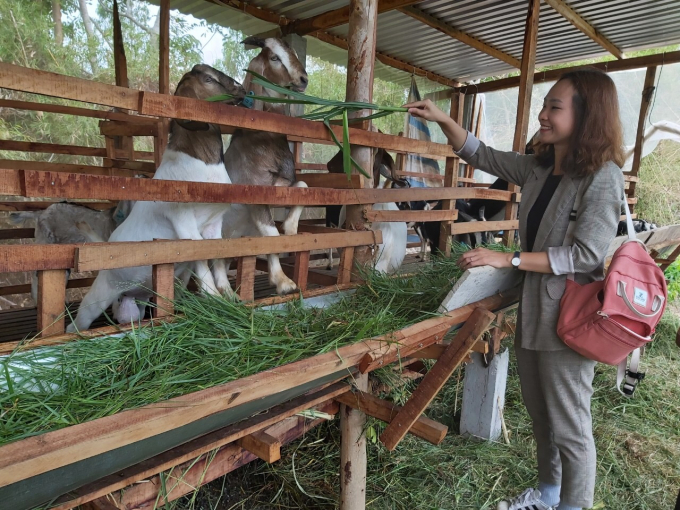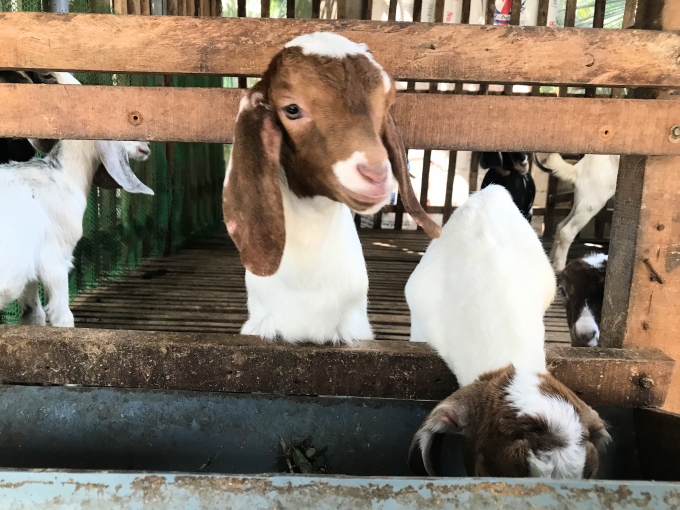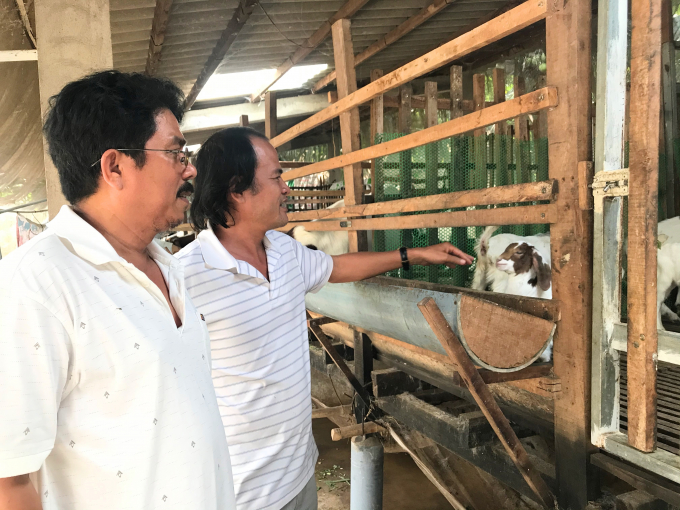November 28, 2025 | 02:52 GMT +7
November 28, 2025 | 02:52 GMT +7
Hotline: 0913.378.918
November 28, 2025 | 02:52 GMT +7
Hotline: 0913.378.918
Tra Vinh province is a pure agriculture region with favorable conditions for farming, where goat farming has been thriving recently. In 2020, due to the uncertain weather, drought, and salinity, land for ineffective rice cultivation due to the saltwater intrusion has been gradually transformed into grass planting for goats. Besides, the Covid-19 pandemic and African swine fever are also the reasons to boost the demands for goat meat consumption. As a result, goat farming is created advantageous conditions to grow.

The model of goat farming in coastal areas is adapted to climate change. Photo: Minh Dam.
The project develops and replicates the model of raising high-quality goats from Bach Thao and Boer goats to adapt to climate change is a ministerial-level scientific project under the Rural and Mountainous Program invested in Tra Vinh province. It is chaired and implemented by the Department of Science and Technology of Tra Vinh province. After nearly 2 years of taking into effect, it has brought high economic efficiency to farmers and the goat herds are all healthy, tall, growing fast.
90% out of a total of 200 female goats of the investment project in Duyen Hai district, Cau Ngang gave birth to 1.25 parity per year, an average of 1.6 heads per female goat. The total herd increased to 720 heads and gave an average income of VND 1.2 million per calf.
According to Assoc. Prof. Dr. Lam Thai Hung, Deputy Director of the Department of Science and Technology of Tra Vinh province, the project has now built up a model, which promotes households to invest in goat breedings. Currently, there are also many households succeeding in breeding Bach Thao's mother goat and the Bo male goat. At first, it assessed that Bo goat was able to adapt well to Tra Vinh climate conditions. More specifically, the calves of Bo goat and Bach Thao goat make better fertile, meeting the standard breed of half-breed goat as recommended by scientists.

Goats are omnivores and easy to raise. Photo: Minh Dam.
Farmer Lam Thanh Day, from Long Vinh commune, Duyen Hai district said that this is the first time he accesses the goat farming model which features 10 female goats and one male goat in a singular herd. Currently, the family's goat herd has 25 more baby goats.
Investment in goat farming is not as difficult as that of a cow due to the shorter time as a four-month-old baby goat can be separated from mom. Goat farmers may garner revenue quickly to settle the family economy. Meanwhile, on average, it takes 13-14 months to raise a cow for sale and the value is only equal to that of 10 baby goats.
We also visited Nguyen Van Nhu’s goat farm, which has 40-year- experience in goat farming in Giong Dai hamlet, Hiep My Tay commune, Cau Ngang district. The farmer was included in the project " Transfer of technical advances and build a farming model of Boer goat and Bach Thao goad, half-breed”. Currently, his farm is having about 70 half-breed goats whose mother and father are Boer goat and Bach Thao goat. He was transferred and trained in technical processes of care, rearing, veterinary medicine, production of food for half- breed goats and initially, gains certain results, accumulating about VND150 million in profit.
Goat feeding is fewer than that of the cow. Currently, there are 10 households in the Duyen Hai district participating in the project, mainly two communes of Long Vinh and Dong Hai.

The goat is a good livelihood choice for coastal farmers. Photo: Minh Dam.
From the efficiency brought about in recent years, the goat has been chosen by the agricultural industry as the main object of structural transformation of livestock besides cows and pigs. In particular, goat farming is very suitable for the model of livelihood adapting to climate change among coastal farmers. Up to now, there are over 13,800 goats. Of which, over 90% of the goat herd produces half-bread goat in the direction of increasing stature and leanness.
Hung said that the project is implemented in the area gathering a large number of Khmer ethnic people and regions affected seriously by climate change. The effective implementation of the project would create a stable livelihood and improve significantly the income of the locals while the situation of climate change is developing seriously.
According to the master plan on restructuring the production of agriculture, forestry, salt production, and fisheries in Tra Vinh province by 2020, with a vision to 2030, goats are one of three types of livestock orienting for development. Specifically, the vision by 2030 the number of province's goats will be 20,000 heads. Tra Vinh province is one of the localities with a large herd of goats in the Mekong Delta. In 2020, the goatherd of this province has over 18,000 heads, ranking 4th in the Mekong Delta. Over the past year, goat farming has become a model bringing high economic efficiency, helping farmers stabilize their lives, as well as contributing to improving the value of the livestock industry in Tra Vinh province.

(VAN) According to Mr. Vo Minh Thanh, Director of the Tay Ninh Department of Agriculture and Environment, Resolution 57 has created a new development pathway for the locality, shifting from traditional toward modern agriculture.
/2025/11/26/4909-2-154329_878.jpg)
(VAN) Pearl grouper farming in HDPE cages not only delivers economic efficiency but also contributes to protecting the environment, creating jobs, and promoting marine-based experiential tourism.

(VAN) The model of making a living under the forest canopy through the agroforestry system in Van Son commune, Bac Ninh province, is expected to generate an annual income of approximately VND 30 million/ha.

(VAN) Many enterprises in Can Tho are harnessing natural energy and reducing greenhouse gas emissions in their production processes, thereby contributing to the promotion of a sustainable green transition.
/2025/11/24/3536-2-112800_176.jpg)
(VAN) Dong Nai now has tens of thousands of hectares of forests certified for sustainable management, and this area will continue to be expanded in the coming period.

(VAN) Vinh Ha hamlet (Dai Xuyen commune, Hanoi) is shifting away from small-scale farming as households adopt bioscurity into their breeder chicken models.

(VAN) Heavy rains make aquatic species more vulnerable to disease. Proactive water management and high-tech systems help farmers prevent outbreaks and protect yields.